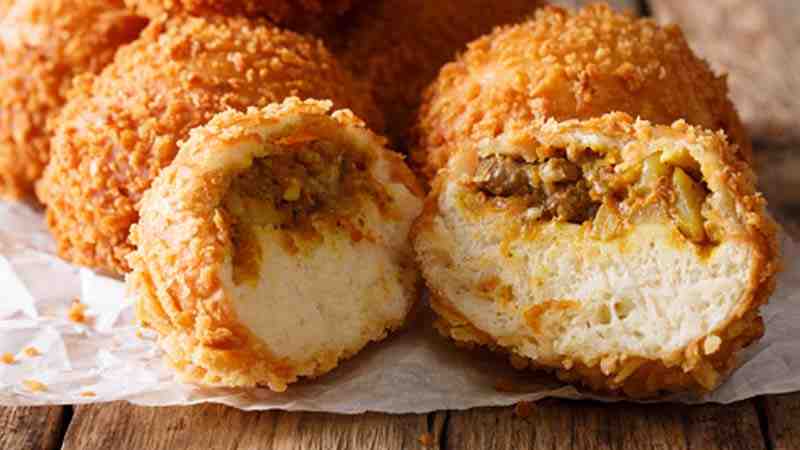Japanese Curry Pan Recipe is a spiced dish popular in Japan and made with chicken, vegetables, and Japanese curry.
The success of the Japanese curry pan was largely due to the discovery of the hot pepper. In 1839, Matsutake Yoshimura found the redcap chili pepper growing wild on Shikoku Island on his way home from buying tools at a tool shop in Hirado.
With its mild flavor, this redcurrant-shaped chili quickly became popular among traders who traveled between Osaka and Shikoku.
How to make Japanese Curry Pan Recipe
Ingredients:
- 1/2 cup chicken stock
- 1/2 cup milk
- 1 bay leaf
- 1-inch cinnamon stick
- 1 tablespoon Japanese curry powder
- 3 green onions (scallions), minced
- 3 tablespoons butter or margarine, unsalted, melted, or warm (optional)
Directions:
Step 1: Preheat the oven to 400°F. Prepare a nonstick pan as shown below.
Step 2: Place chicken pieces in a pan and season with salt and pepper.
Step 3: Pour milk over chicken, add bay leaf, cinnamon stick, curry powder, and green onions. Bake for 30 to 40 minutes until chicken is cooked through (170°F internal temperature). Makes 4 servings of 1/4 cup each.
Step 4: Serve and enjoy!
Nutrition facts of Japanese Curry Pan Recipe
- Calories: 17
- Fat: 1.7 grams
- Saturated fat: 0.4 grams
- Cholesterol: 4 milligrams
- Sodium: 1,400 milligrams
- Carbohydrates: 1 gram
- Protein: .6 gram
Health Benefits of Japanese Curry Pan Recipe
Dietitians recommend including chicken or poultry in the diet is good for health. Studies have shown that including protein in the daily diet helps maintain healthy bones and muscles and may lower the risk of some types of cancer.

Chicken and poultry are low in fat and can be a part of many weight control and heart-healthy eating plans.
Best 5 Serving Ideas for Japanese Curry Pan Recipe
1. Create your low-fat chicken curry by substituting the butter with vegetable oil. Serve alongside brown rice and enjoy a healthy meal.
2. Mix up an Asian Chicken Curry with vegetables, including red pepper, mushrooms, carrots, and mushrooms. Sprinkle some grated ginger and sesame seeds on the chicken as it cooks.
3. Japanese Curry Pan Recipe also works well with salmon fillets, which are good for your heart, brain, and bones due to their omega-3 fatty acids.
4. Chicken curry is also a versatile dish that can be served with pasta, rice, and bread.
5. Add the curry to the Egg Salad or mix with mayonnaise and serve on sandwiches.
History of Japanese Curry Pan Recipe
The origin of curry in Japan is said to have come from the introduction Indian cuisine to Japan by the Portuguese in the 16th century.
The Japanese term “kare” was derived from the word “karat,” which refers to the spicy foods introduced by Portuguese merchants. The Chinese traders also brought their curry recipes (known as Kari) and introduced curry powder in the 1800s to Japan.
Curry pan recipe baked
Over the years, the Japanese incorporated their tastes and style into the curry pan recipe. The Japanese curry pan recipe was created in 1950.
It was invented by a housewife called Mrs. Matsuo, who partnered with sauce manufacturer Takao Aoki to create “Kame no Ana” curry sauce that could be made from scratch and sold at convenience stores.
Japanese curry buns
With the creation of curry buns in Japan, we can now find curry pan recipes on the menus of many different fast-food chains and convenience stores.

Curry pan is also a popular party food. It can be served in little cones or Japanese-style foldable baskets (O-musubi).
How to store?
When storing Japanese Curry Pan Recipe leftovers, it is best to refrigerate tightly covered and away from warm, humid foods as they will cause the curry sauce to dilute. Avoid refrigerating in aluminum foil or plastic wrap as this will delay cooling.
Is It Suitable For Pregnant Women?
The Japanese curry pan recipe is generally safe for pregnant women to eat. As long as the chicken is cooked thoroughly, there is no risk of food causing health problems.
Maintain a low-fat diet and consume moderate amounts of fish and vegetables for health benefits during pregnancy.
Is It Kids Friendly?
Yes. There is no concern with the Japanese curry pan recipe in children younger than 6. Before eating this dish, children over 6 years of age should consult their pediatrician first.
Side Effects of Japanese Curry Pan Recipe
The Japanese curry pan recipe is considered safe to eat by most people. Side effects may include gastroenteritis, nausea, and allergic reactions.
If you experience these symptoms after consuming a Japanese curry pan recipe, seek medical attention immediately.
Specialty of Japanese Curry Pan Recipe
The Japanese curry pan recipe is a good option to start a low-fat diet. It is also easier to make than regular curry sauces.
How to Eat?
When eating the Japanese curry pan recipe, the sauce should be poured over white rice and eaten with chopsticks.
If you like your curry spicy, add ground chili pepper or red pepper flakes on top of the chicken before baking in the oven.
Conclusion
If you love the authentic taste of the Japanese curry pan recipe but have trouble making it at home, check out stores that sell ready-made curry pans. You can now find Japanese curry pans in supermarkets.
FAQ
What spices to put in Japanese curry?
Spices in the Japanese curry pan recipe can be adjusted according to your taste preferences. The Japanese curry pan recipe may include dried fish, salt, and sugar.
Can you add chickpeas to Japanese curry?
Yes. Chickpeas are added to the curry sauce in some recipes. You can add this ingredient to your curry pan recipe if you would like.
What is the difference between Japanese curry and Indian curry?
Many Japanese and Indian curries are considered similar dishes, but there are many differences. The Japanese cooking style is lighter, so it does not use as much oil as traditional Indian curries do.